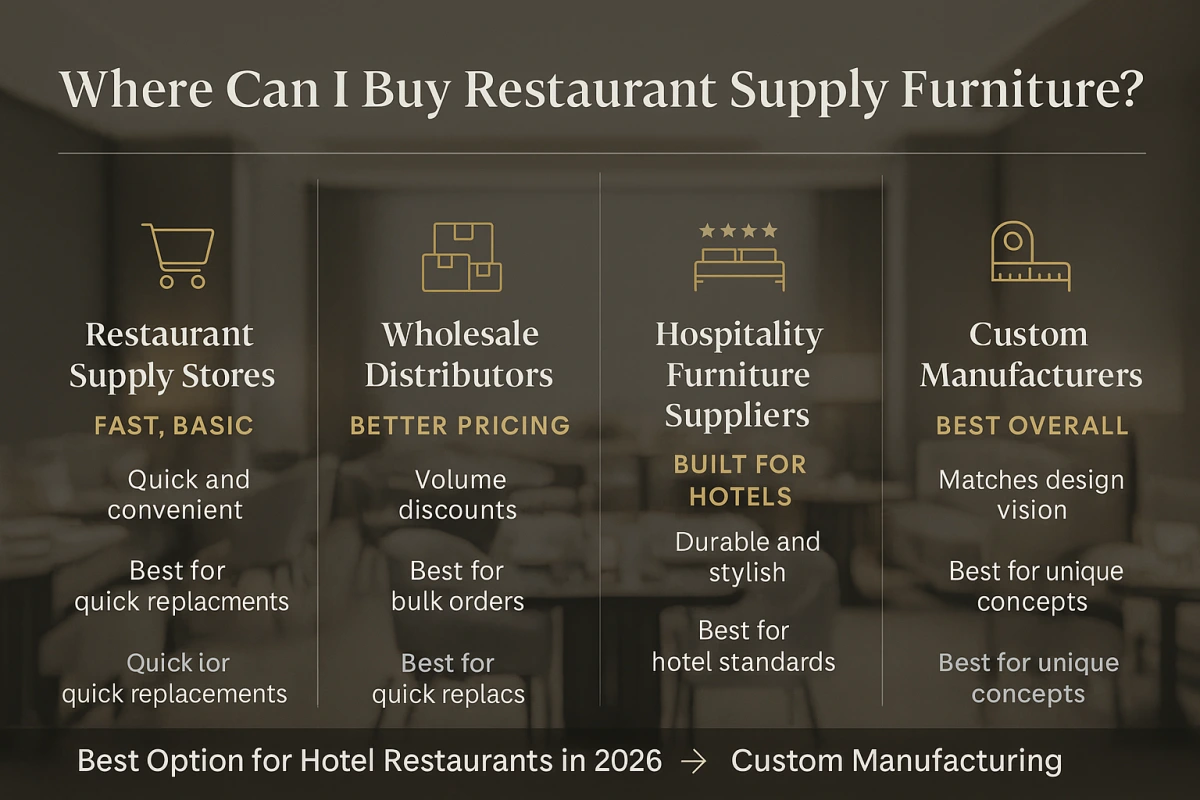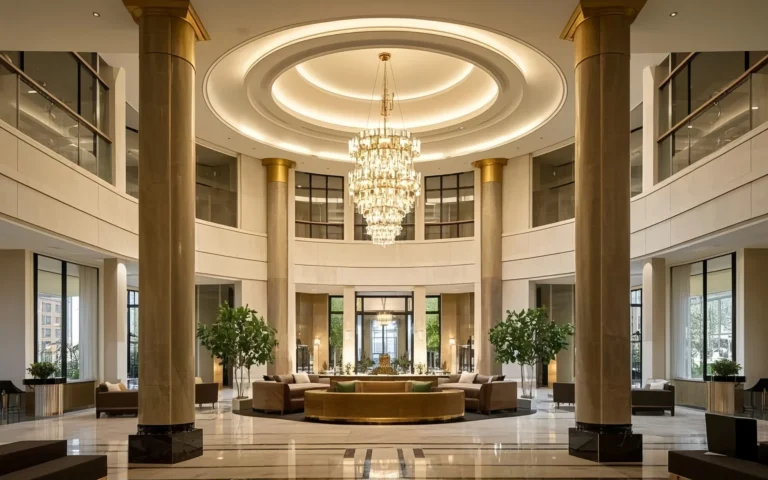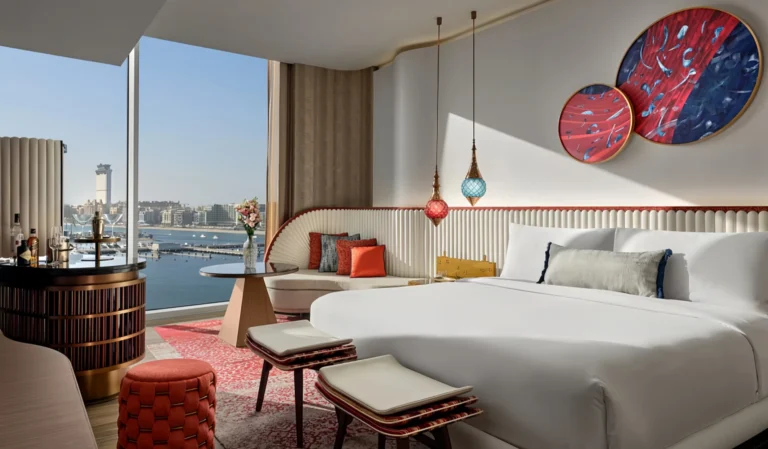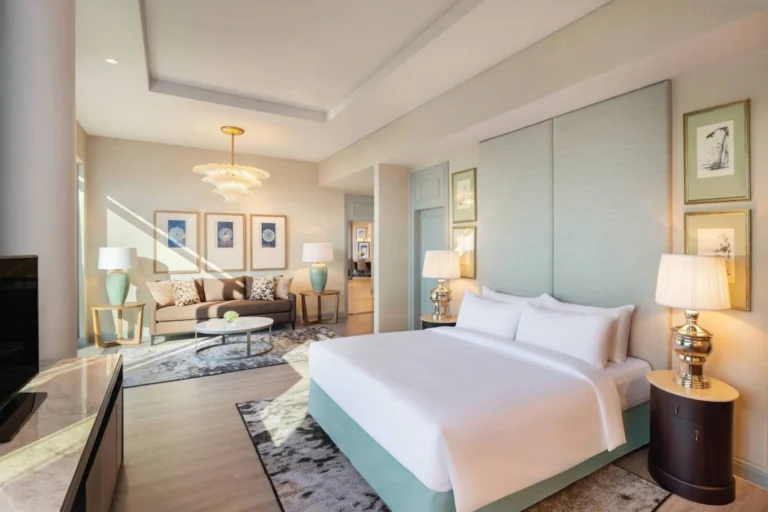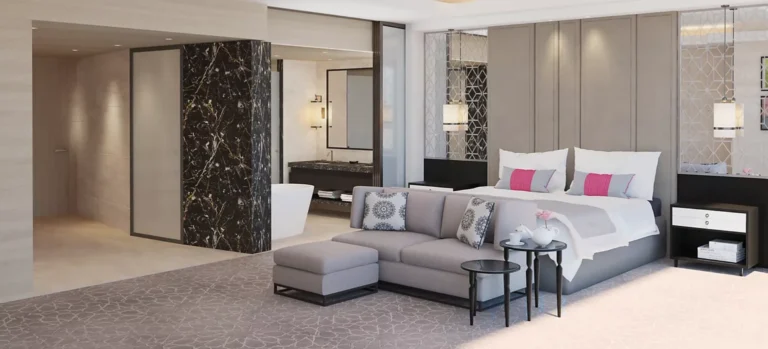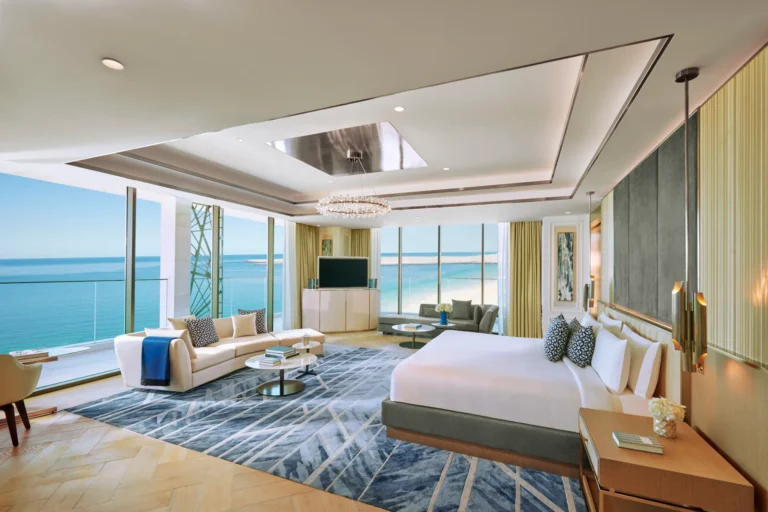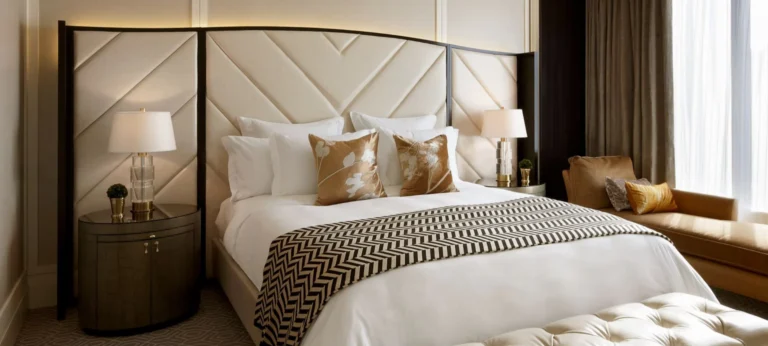When guests walk into a hotel restaurant, they don’t just see furniture—they feel it. The chairs, the tables, the layout, the materials… all of these silently shape comfort, atmosphere, and even how long guests decide to stay.
In the past, furniture was treated like a finishing touch. Today, it’s a strategic design tool that affects guest experience, brand identity, and revenue. In other words: furniture isn’t just decoration anymore—it’s performance.
A well-designed hotel restaurant does three things effortlessly:
Creates a memorable first impression
Design that captures attention from the moment guests walk in.
Makes guests feel comfortable and welcome
Seating, spacing, and materials that naturally invite people to stay.
Supports smooth service & operations
Layouts and furniture that help staff work efficiently without disruption.
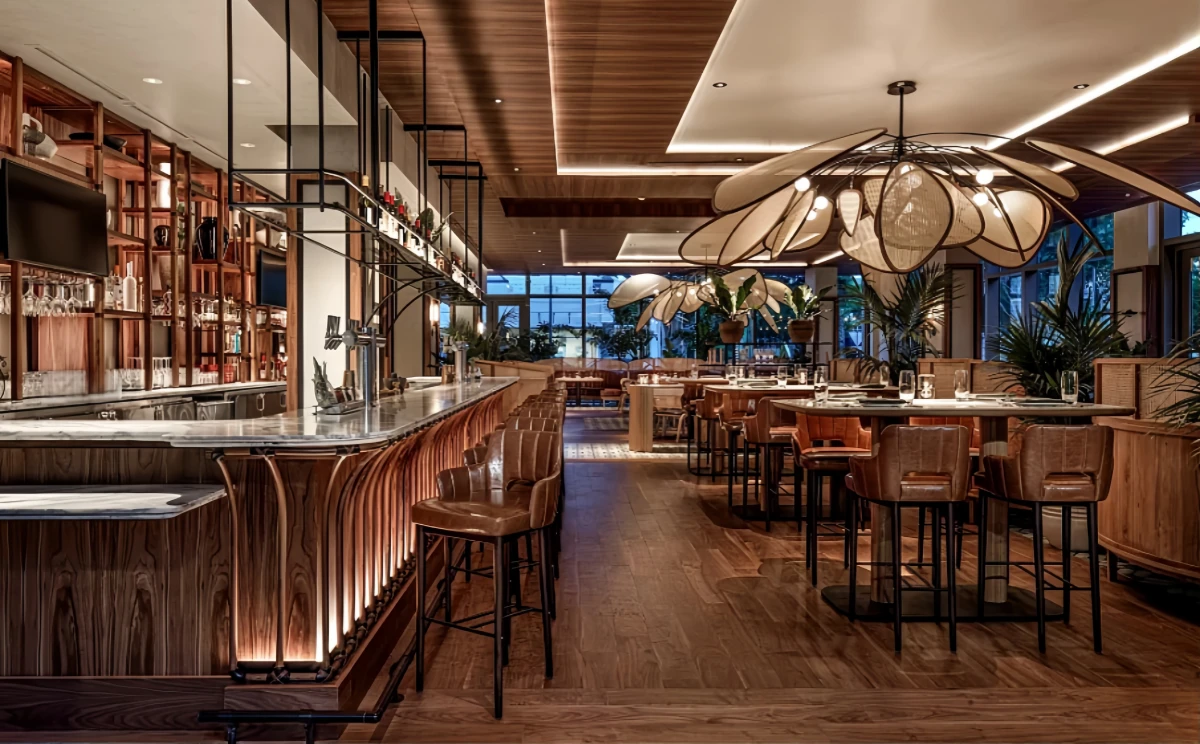
In this guide, we’ll explore the best hotel restaurant furniture design ideas for 2026...
Core Design Principles for Modern Hotel Restaurant Spaces
Start with Space Planning & Flow
How do guests transition from dining to lounge or bar areas? Good furniture design supports movement, not blocks it. Wide aisles, logical table spacing, and clear paths create a relaxed environment and smoother service.
Before choosing furniture, understand how people will move through the space:
- Where do guests enter?
- How do they check in or get seated?
- How does staff serve, clear, and reset tables?
Use Zoning to Shape Different Experiences
By mixing different seating zones, you can serve couples, families, business guests, and social groups—all in one smart layout.
A great hotel restaurant usually offers more than one seating style:
- Standard dining tables
- Cozy booth seating for privacy
- High-top or bar seating for casual drinks
- Lounge or sofa areas for relaxed conversations
- Communal tables for social interaction
Let Furniture Reflect the Brand Story
Every hotel has a personality. The restaurant furniture should speak that language. The furniture is part of the storytelling—guests should feel your brand just by sitting down.
- Luxury hotel? Premium materials, elegant silhouettes.
- Boutique hotel? Artistic shapes, bold fabrics, local craftsmanship.
- Resort? Natural textures, relaxed seating.
- Business hotel? Clean lines, efficiency.
Balance Comfort and Aesthetics
A chair can look stunning—but if it’s uncomfortable after 20 minutes, guests won’t stay for dessert. In 2026, hotels are prioritizing “residential-level comfort with hospitality-level durability.”
That means:
- Soft yet supportive seat cushions
- Correct seat height and depth
- Ergonomic back support
- Armrests where appropriate
- Stable, solid frames
Make Furniture and Lighting Work Together
Lighting can completely change how furniture feels. When lighting and furniture are designed together, the atmosphere feels intentional and high-end.
- Pendant lights above tables for intimacy
- Wall sconces to highlight textures
- Floor lamps in lounge zones
- Integrated lighting in shelves or banquettes
Design for Flexibility and Multi-Use
Hotel restaurants often serve breakfast, lunch, dinner, events, and even co-working in the same space. The solution? Flexible furniture.
- Lightweight chairs that can be moved easily
- Modular tables that combine or separate
- Banquettes that double as lounge seating
- Stackable or foldable items for event setups
Think Long-Term: Durability & Maintenance
In hospitality, furniture must survive thousands of uses. Smart hotel restaurant furniture design = beauty + comfort + function + brand alignment + operational efficiency.
- Stain-resistant fabrics
- Scratch-resistant surfaces
- Solid construction
- Easy-to-clean shapes
- Replaceable parts
Top Hotel Restaurant Furniture Design Styles in 2026
In 2026, hotel restaurant design is all about creating memorable atmospheres through furniture, materials, and layout. Here are the most popular styles shaping modern hotel dining spaces—and how furniture plays a key role in each one.
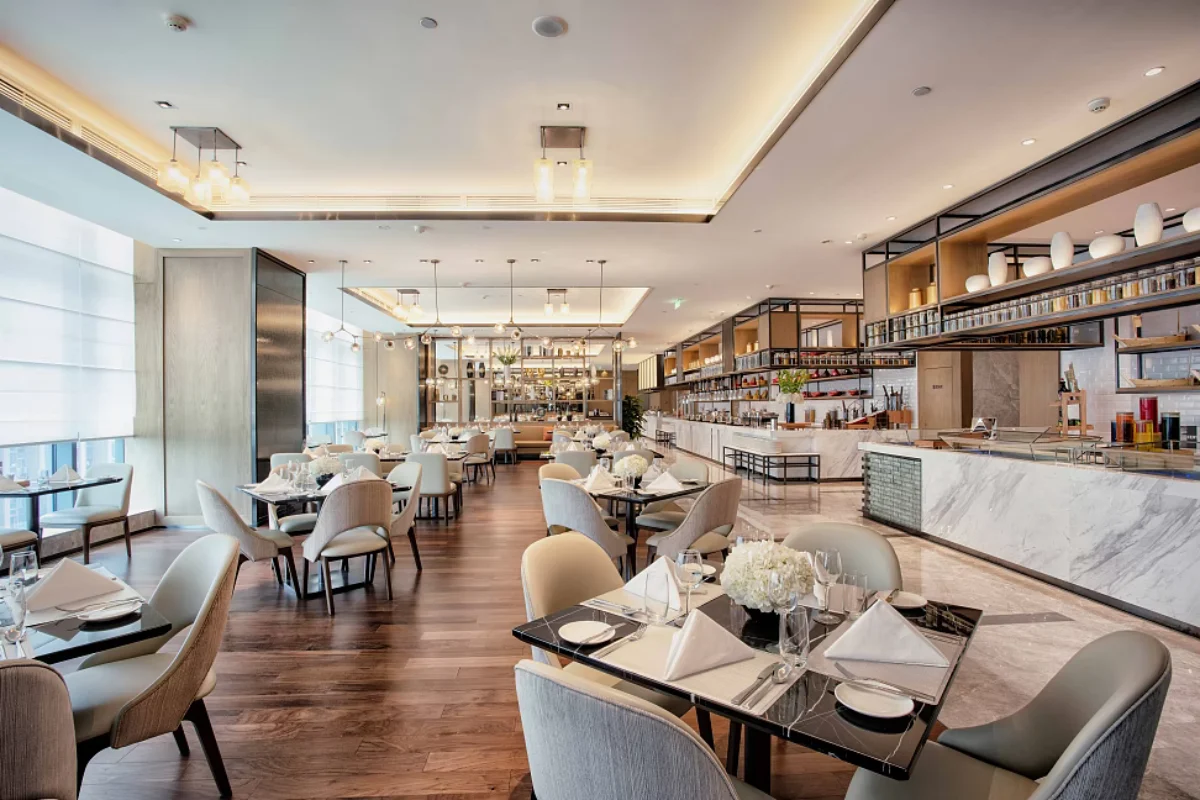
Elegant Contemporary Minimalism with Light Luxury Touch
This design shows how modern hotel restaurants can feel both clean and high-end without being overly formal. The space uses soft neutral colors, smooth surfaces, and slim-profile furniture to create a calm, welcoming atmosphere. The layout is open and airy, allowing guests to move comfortably while still feeling intimate at each table.
- Light upholstery and curved chairs add softness and comfort
- Dark marble tabletops bring a touch of luxury without being overwhelming
- Warm wood flooring balances the cool tones of the space
- Built-in shelving and linear lighting create visual order and sophistication
- Minimal decoration keeps the design timeless and easy to maintain
This is a perfect example of contemporary minimalism upgraded with subtle luxury, making it ideal for upscale all-day dining restaurants in modern hotels.
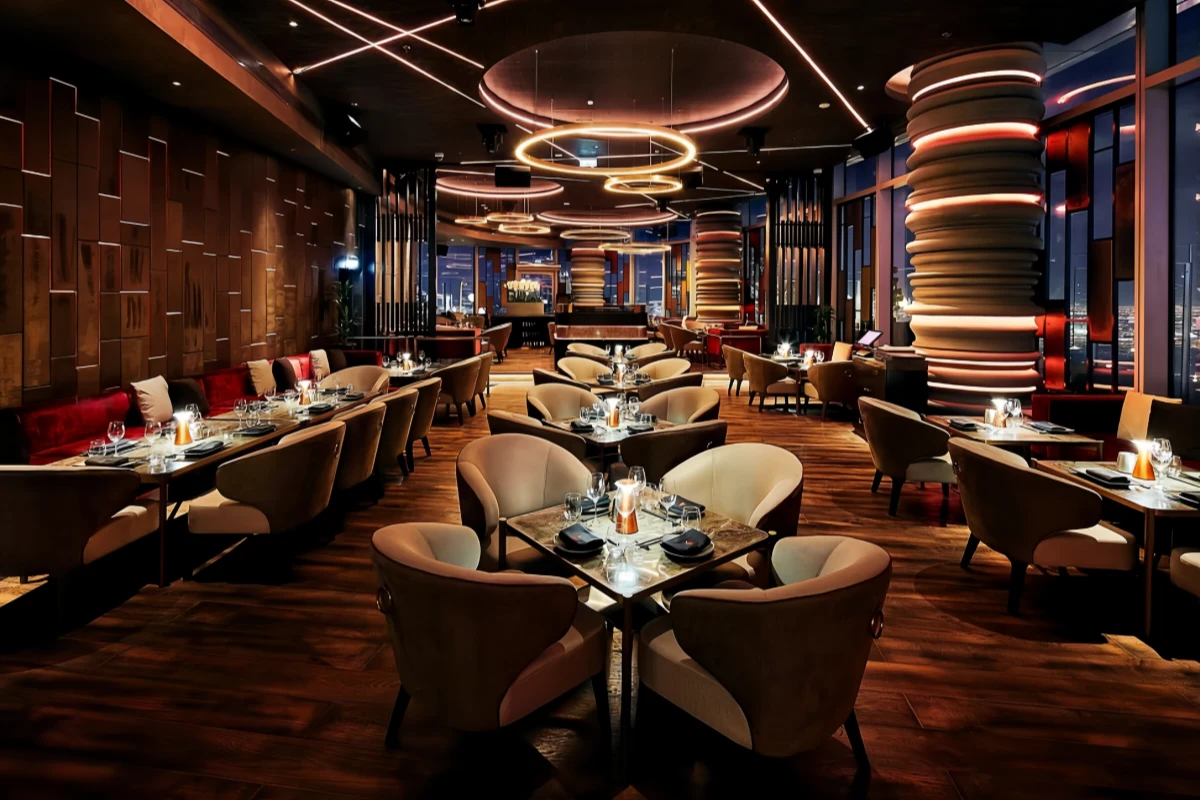
Modern Luxury Dining with Dramatic Atmosphere
This design captures the essence of high-end, evening-focused hotel restaurant experiences. Instead of relying on bright lighting and neutral tones, it uses deep colors, rich textures, and sculptural lighting to create an intimate, luxurious mood. The circular ceiling lights and curved furniture shapes soften the space and make it feel exclusive and immersive.
- Warm lighting and layered ceiling design add drama and depth
- Plush, curved armchairs provide comfort and a premium feel
- Dark wood flooring and wall panels create warmth and richness
- Long banquette seating maximizes capacity while maintaining intimacy
- Accent colors like deep red add personality and sophistication
This is a perfect example of modern luxury with a nightlife twist—ideal for upscale hotel restaurants, rooftop lounges, and fine-dining venues where atmosphere is everything.
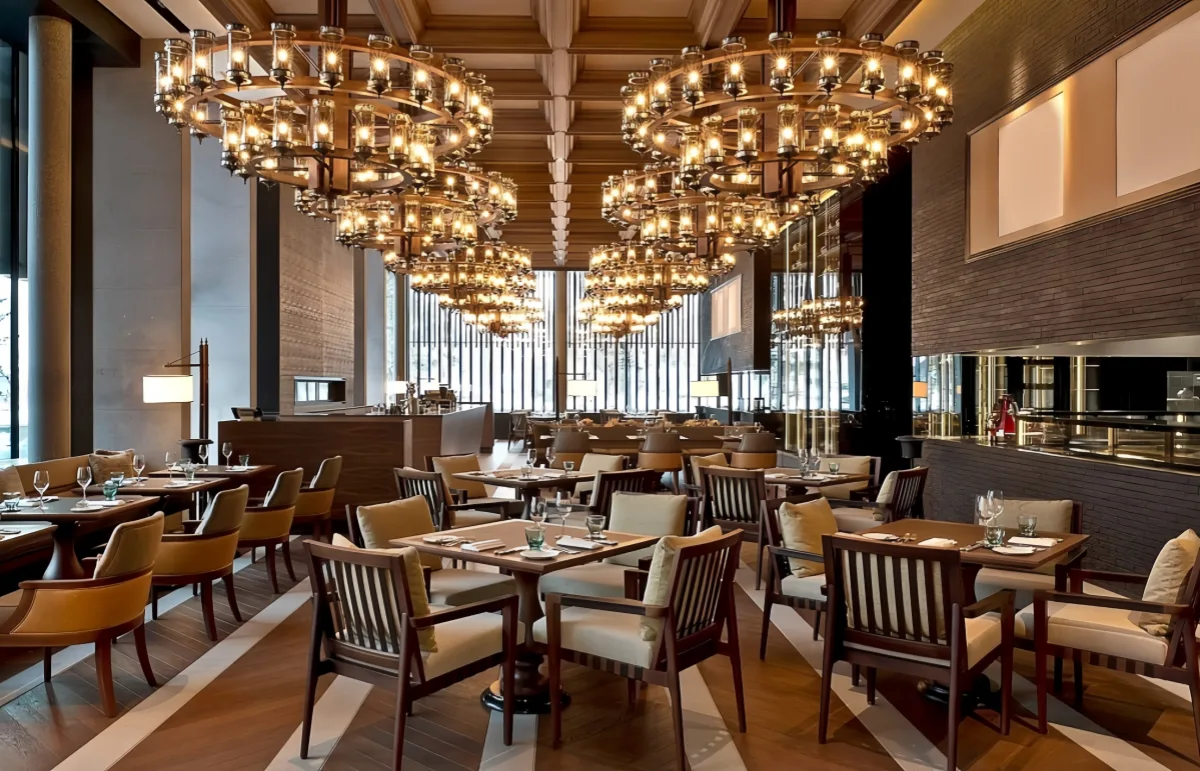
Modern Classic Luxury with Grand Architectural Presence
This design blends traditional elegance with modern refinement, creating a high-end dining environment that feels both timeless and impressive. The double-height ceiling and dramatic chandeliers instantly elevate the space, while the clean-lined furniture keeps it current and comfortable.
- Oversized chandeliers act as statement pieces and set a luxurious tone
- Warm wood furniture adds richness and natural warmth
- Upholstered armchairs ensure guest comfort for long meals
- Symmetrical layout creates a sense of order and prestige
- Tall vertical windows bring in natural light and balance the heavy materials
This style is ideal for 5-star hotel restaurants, fine dining venues, and upscale brunch spaces that want to project authority, elegance, and long-term brand value.
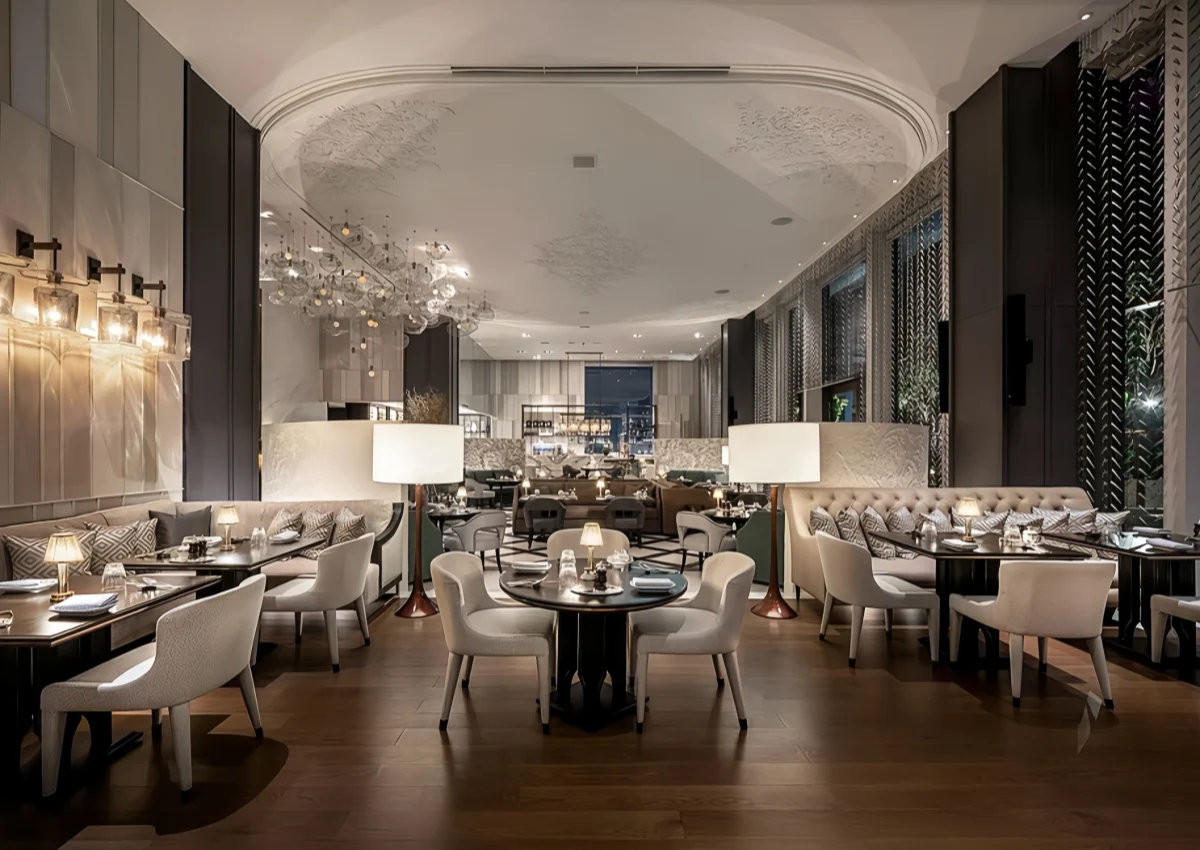
Soft Boutique Luxury with Artistic Detailing
This design showcases a refined blend of boutique charm and modern luxury. Instead of being bold or dramatic, it uses soft tones, elegant curves, and layered textures to create a calm, intimate, and visually rich dining experience. The space feels upscale, but also welcoming and emotionally warm—an ideal balance for high-end boutique hotels.
- Soft neutral color palette (cream, taupe, grey) adds calm and sophistication
- Curved banquettes and upholstered chairs create comfort and unity
- Decorative ceiling and artistic lighting add subtle visual drama without overwhelming
- Floor lamps and table lamps provide a cozy, residential-style ambiance
- Thoughtful zoning allows privacy while maintaining openness
This is a beautiful example of boutique luxury done with softness and detail, perfect for lifestyle hotels and elegant fine-dining concepts that want personality without being loud.
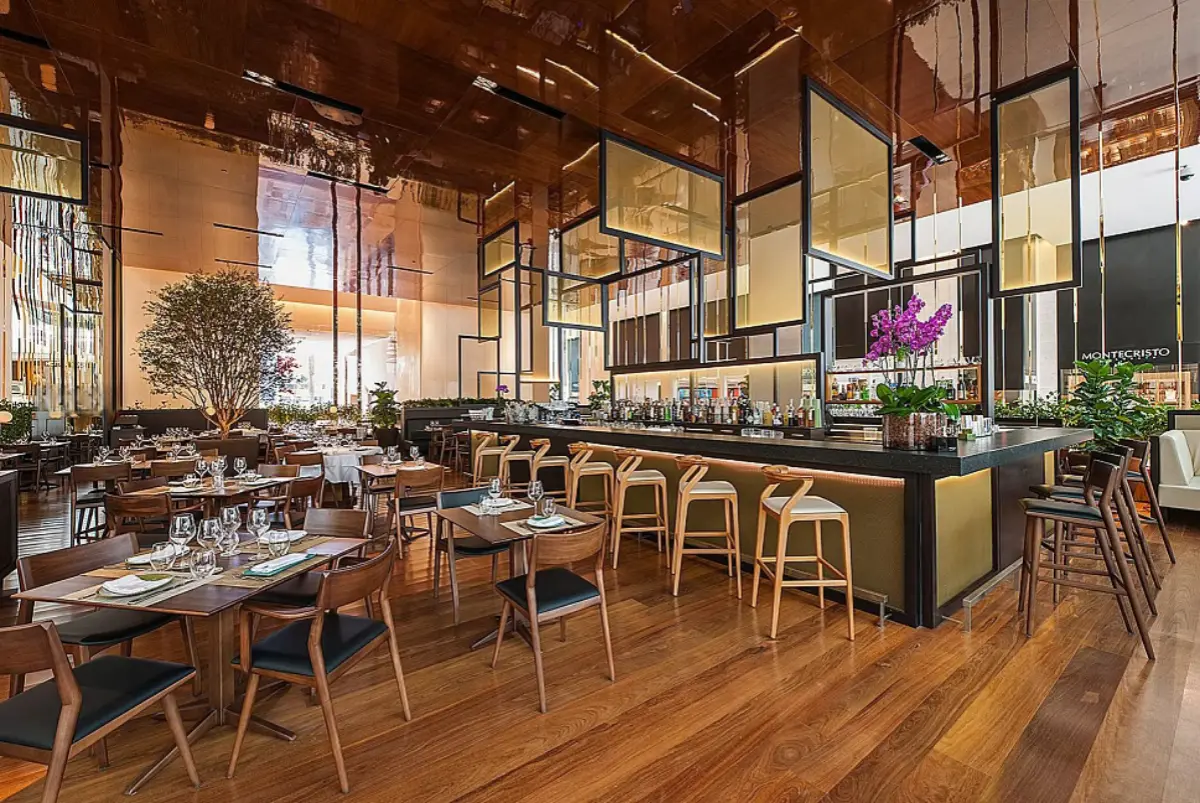
Warm Contemporary with Natural Materials and Architectural Drama
This design is a perfect example of how modern hotel restaurants can feel fresh, vibrant, and high-end without being overly formal. The space blends warm wood tones, mid-century style furniture, and bold architectural elements to create a lively yet refined dining experience.
- Wooden chairs and flooring create warmth and a natural, welcoming feel
- Mid-century inspired furniture adds timeless elegance with modern comfort
- Layered ceiling panels and hanging frames introduce visual depth and movement
- Integrated bar seating provides flexibility for dining and socializing
- Touches of greenery and floral accents add freshness and balance the warm palette
This design style is ideal for contemporary hotel restaurants, lifestyle hotels, and upscale casual dining spaces that want to feel modern, energetic, and connected to natural materials—without losing sophistication.
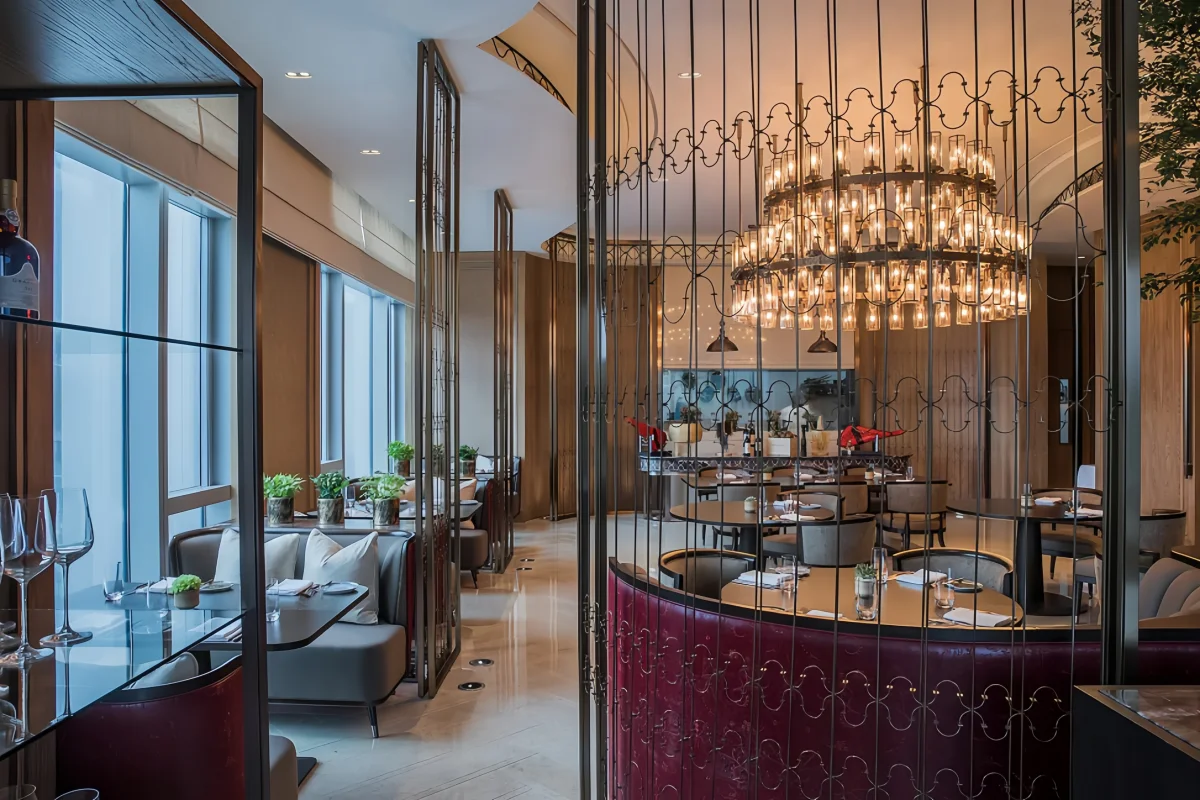
Elegant Luxury with Artistic Detailing and Intimate Layouts
This design beautifully showcases how hotel restaurants can feel both high-end and intimate. Instead of one open dining hall, the space uses curved booth seating, decorative metal partitions, and layered lighting to create private pockets of dining—perfect for guests who value comfort and exclusivity.
- Curved banquette seating with rich upholstery adds luxury and intimacy
- Decorative metal screens subtly divide space without blocking visual flow
- Statement chandelier becomes the centerpiece, adding drama and elegance
- Soft neutral tones + deep accent colors (like wine red) balance warmth and sophistication
- Natural light + indoor greenery create a refreshing, high-end wellness feel
This style is ideal for luxury hotel restaurants, fine dining venues, and boutique hotels wanting a refined yet emotionally engaging atmosphere. Every detail—from the furniture curves to the layered lighting—feels custom-crafted to elevate the guest experience.
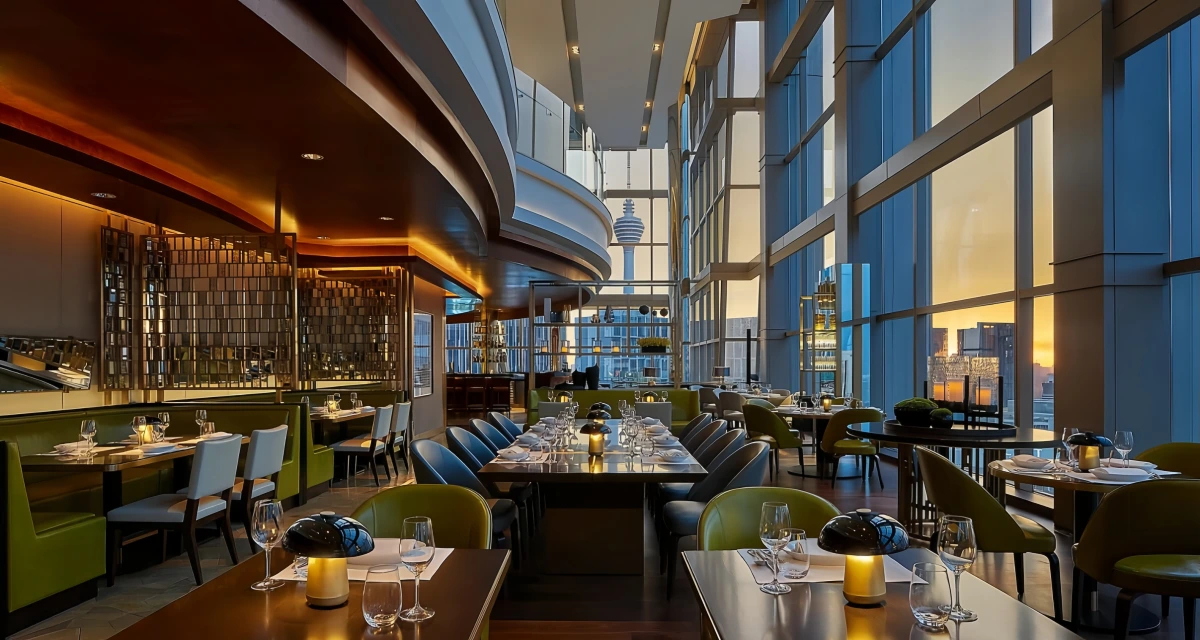
Panoramic Luxury with Urban Modern Design
This hotel restaurant design takes full advantage of breathtaking city views, turning the skyline into part of the furniture design itself. Floor-to-ceiling windows, slick materials, and soft ambient lighting create an elevated dining experience—both literally and visually.
- 360° city views become the main visual feature
- Curved ceiling lines & architectural shapes add movement and sophistication
- Modern upholstered chairs in deep green and neutral tones create a refined, upscale feel
- Clean-lined tables + soft candle lighting strike a balance between business dining and romantic atmosphere
- Subtle space dividers maintain flow while offering semi-private dining zones
This design is perfect for rooftop restaurants, luxury city hotels, and high-end lounges that want to blend fine dining with urban energy. The furniture remains comfortable and elegant, but the real “wow factor” comes from how everything frames the view.
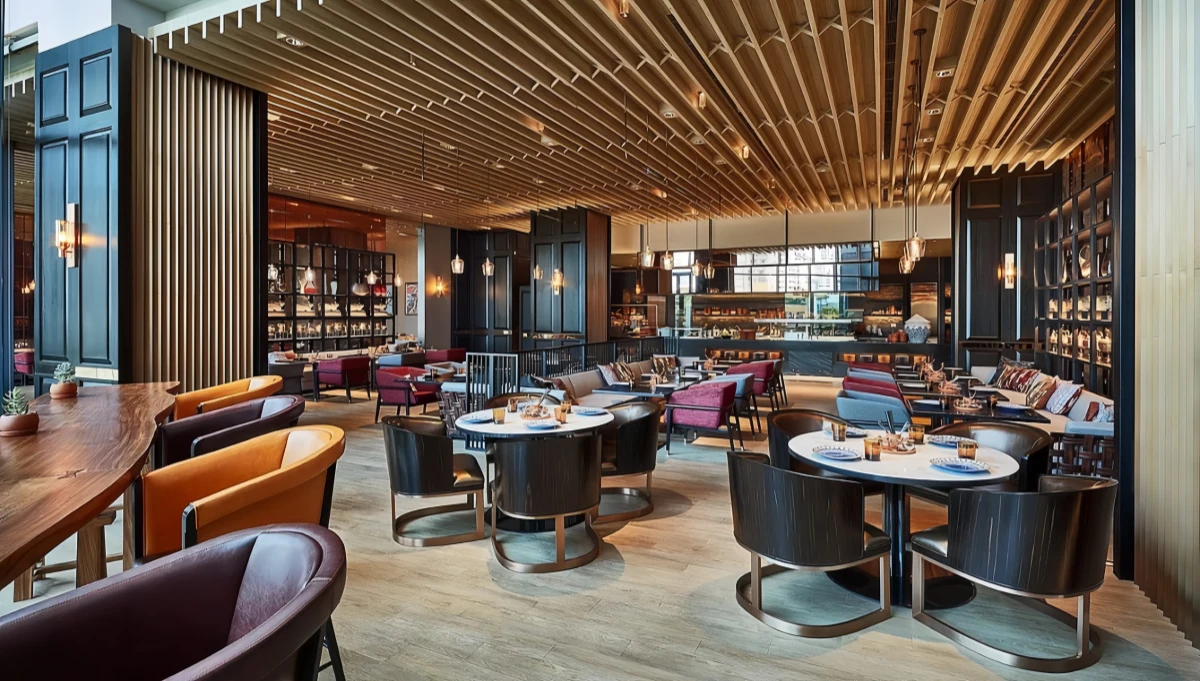
Eclectic Social Lounge Style – Designed for Connection & Personality
This hotel restaurant blends lounge comfort with dining functionality, creating a space that feels warm, stylish, and highly social. Instead of one uniform seating style, it uses variety to make the experience more dynamic and memorable.
- Mixed seating options – curved lounge chairs, sofas, bar stools, and dining chairs all in one space
- Bold color accents – deep reds, mustard yellow, rich leather tones for personality and warmth
- Open lounge layout – ideal for casual meetings, afternoon tea, or evening cocktails
- Wood ceilings and floors – add natural texture and a cozy upscale feel
- Custom-built banquettes & circular seating – perfect for groups and extended socializing
- Integrated shelving and decor – showcases art, books, or local culture to add character
This design is perfect for boutique hotels, lifestyle hotels, and urban social dining spaces that want more than a traditional restaurant—something that feels like a stylish living room where people naturally gather, stay longer, and enjoy the atmosphere.
Custom Hotel Restaurant Furniture – Why It’s the New Standard
Standard furniture may work for everyday restaurants, but hotel restaurants are different. They serve multiple functions, represent the brand, and must create a memorable guest experience. That’s why more hotels in 2026 are choosing custom furniture instead of off-the-shelf options.
Here’s why custom furniture has become the new standard:
1. Perfect Fit for Unique Layouts
Every hotel restaurant has its own floor plan. Custom furniture is designed to match the exact space—no wasted corners, no awkward gaps, better seating capacity, and more efficient circulation.
2. Strong Brand Identity
Furniture can express a brand’s personality better than any artwork or sign. Custom shapes, materials, colors, and details make the space instantly recognizable and consistent with the hotel’s style.
3. Better Guest Experience
Custom seating can be tailored for comfort, privacy, conversation, or social interaction. Whether it’s a cozy booth or a luxurious lounge chair, guests feel the difference immediately.
4. Integrated Functionality
Custom furniture can include built-in lighting, power outlets, storage, dividers, or technology. This improves convenience for guests and efficiency for staff.
5. Higher Quality and Durability
Hospitality-grade custom furniture uses stronger frames, commercial fabrics, and long-lasting finishes. It survives thousands of uses and still looks new—saving money in the long run.
6. Flexibility for Any Concept
Fine dining, buffet, café, rooftop bar, or multi-use space—custom furniture can be designed for any concept and adjusted as your brand evolves.
7. Full Project Support
The best manufacturers don’t just build furniture—they help with design, engineering, prototyping, production, delivery, and even installation. This ensures everything fits perfectly and arrives on time.
Where Can I Buy Restaurant Supply Furniture?
Finding the right restaurant furniture is not just about buying tables and chairs—it’s about choosing pieces that match your design vision, meet hospitality-grade durability, and support a great guest experience. In 2026, hotel restaurants need furniture that’s stylish, functional, and built for heavy daily use. There are several ways to source furniture, but each option offers a very different level of quality, flexibility, and control.
Below are the four most common purchasing channels—along with real supplier examples and when each option makes sense.
Restaurant Supply Stores (Fast, but Basic)
These are retail or online stores that sell ready-made tables, chairs, and bar stools. They’re easy to buy from and great for quick replacements or small projects. However, most products are generic and not designed for hotel-level aesthetics or durability.
- Quick and convenient
- Budget-friendly
- Immediate availability
- Limited style and sizing
- Mostly standard commercial quality
- No customization or brand identity
- WebstaurantStore (USA) – Large selection of basic restaurant furniture
- RestaurantFurniture.net (USA) – Affordable, off-the-shelf seating and tables
Wholesale Furniture Distributors (Better Pricing, Less Design Control)
Wholesalers offer a wider product range and better pricing at scale. They often carry multiple brands and styles, making them useful for bulk orders. However, the design may not match the hotel’s style perfectly, and customization is limited.
- Volume discounts
- More variety than retail
- Some commercial-grade options
- Designs may feel generic
- Limited flexibility on finishes/sizes
- Quality varies by supplier
- Global Furniture Group (USA) – Contract furniture with large distribution
- Eurosupply (Europe) – Supplies restaurants and hospitality businesses
Hospitality Furniture Suppliers (Designed for Hotels & Restaurants)
These companies specialize in contract-grade furniture made specifically for the hospitality industry. They understand hotel requirements like durability, fire safety, and style consistency. Many offer semi-custom options.
- Built for hotel use (durability + safety)
- Better design coordination
- Semi-custom options available
- Experience with hospitality projects
- Higher cost than retail/wholesale
- Some limitations in full customization
- Bryan Ashley (USA) – One of the largest hospitality furniture suppliers
- Kimball Hospitality (USA) – Known for upscale hotel casegoods and seating
- Curtis Furniture (UK) – Specializes in hotel and restaurant FF&E with custom capabilities
Custom Hotel Restaurant Furniture Manufacturers (Best Overall Choice)
This is the most popular direction in 2026 for high-end hotels, boutique concepts, and lifestyle brands. Instead of adapting your design to standard furniture, custom manufacturers build furniture around your exact layout, style, and brand identity.
- Perfect fit for the space (no wasted area)
- Fully aligned with brand aesthetics
- Designed for guest comfort and functionality
- High durability and better long-term value
- Can integrate lighting, power, storage, or tech
- One partner can handle design, production, and installation
- Yabo Furniture (China) – Trusted by Hilton, Marriott, Hyatt, and other 5-star hotels
- Stellar Works (China) – International design brand used in boutique and luxury hotel restaurants
- Censo Home (China)– Offers full custom hotel restaurant furniture solutions, from design to manufacturing to export; ideal for projects needing flexibility, style, and end-to-end support
So… What’s the Best Way to Buy?
If you only need basic tables and chairs, retail or wholesale might work. If you want quality and hospitality standards, go with a dedicated hospitality supplier. But if you want a restaurant that truly reflects your brand, maximizes space, and wows your guests—custom manufacturing is the smartest choice.
2026 Hotel Restaurant Furniture Design Trends You Can’t Ignore
Hotel restaurants in 2026 are no longer just dining spaces—they’re social hubs, brand showcases, and guest experience centers. Furniture plays a major role in shaping how these spaces feel and function. Here are the top trends driving hotel restaurant furniture design in 2026—and why they matter.
1. Experience-Driven Seating Layouts
Instead of uniform rows of tables, hotels are creating layered experiences.
- Intimate two-top seating for couples
- Lounge sofas for casual dining or coffee
- Communal tables for social interaction
- Bar seating for flexible day-to-night use
2. Mixed Seating Styles for Visual Interest
Using only one type of chair makes a restaurant look flat. The new trend is mixing:
- Upholstered chairs + wooden chairs
- Benches + booths + armchairs
- Bar stools + lounge seating
This creates depth, personality, and a more residential, comfortable feel.
3. Softer Shapes & Curved Furniture
Straight lines feel formal. Curves feel welcoming.
- Rounded tables
- Curved booth seating
- Organic-shaped lounge chairs
- Soft-edge bar counters
Curves also improve flow and reduce sharp corners in tight spaces.
4. Natural & Sustainable Materials
Sustainability is no longer just a “nice-to-have”—it's a brand value. Hotels are choosing:
- Solid wood and veneer with eco certifications
- Recycled or low-VOC materials
- Rattan, cane, or stone details
- Fabrics made from natural or recycled fibers
Furniture that looks natural also creates a calming, biophilic atmosphere.
5. Warm Color Palettes
Instead of cold greys and pure white, colors are shifting to:
- Warm neutrals (beige, sand, taupe)
- Earthy tones (terracotta, olive, clay)
- Muted pastels (sage, blush, dusty blue)
- Deep accents (midnight blue, forest green, burnt orange)
Warm tones make dining spaces feel more welcoming and premium.
6. Residential-Level Comfort with Commercial Durability
Guests want hotel restaurants to feel like stylish homes—BUT the furniture still needs to handle heavy daily use.
- High-density foam cushioning
- Soft upholstery with performance fabrics
- Ergonomic seat angles
- Reinforced frames and contract-grade finishes
Comfort = longer stays = higher F&B revenue.
7. Modular & Flexible Furniture
Hotel restaurants serve breakfast, lunch, dinner, events, and sometimes even co-working. One layout can’t do it all. That’s why modular furniture is trending:
- Tables that can link or separate easily
- Stackable or foldable chairs
- Movable banquettes
- Multi-use bench seating
Flexibility = more ways to use the space without remodeling.
8. Blurring Restaurant, Bar & Lounge Zones
The most modern hotel restaurants don’t look like “just restaurants.” They blend:
- Dining + bar counter
- Lounge + waiting area
- Coffee corner + workspace
- Social + private areas
Furniture helps define each mood without using walls—through height, shape, materials, and layout.
9. Statement Pieces That Act as Identity
Hotels are using one bold furniture element to make the space memorable:
- Sculptural chairs
- Custom banquette with unique shape
- Artistic communal table
- Signature lighting integrated with furniture
One strong design element = instant brand recognition.
10. Tech-Integrated Furniture
Technology is moving into furniture in subtle ways:
- Built-in charging in tables
- Wireless charging in bar counters
- LED lighting inside booths or shelves
- Acoustic panels in seating to reduce noise
- Smart tables for events or presentations
Tech is not the focus—but it enhances usability and guest comfort.
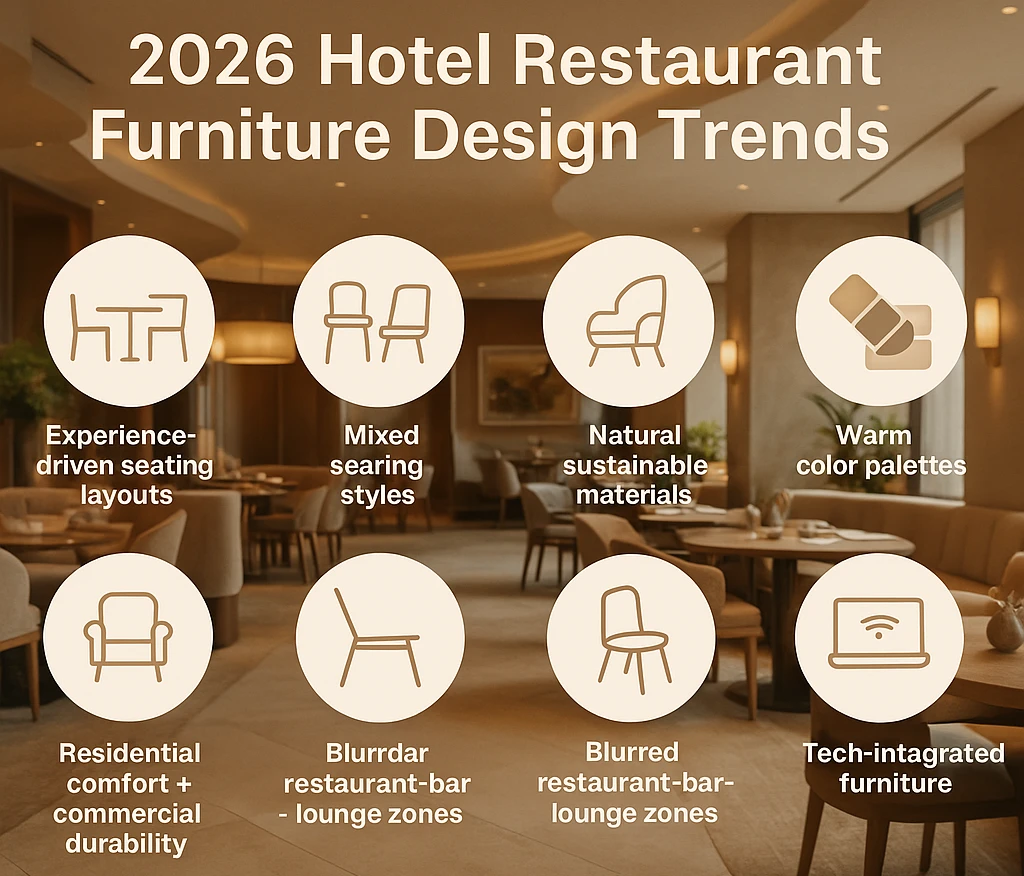
Conclusion – Creating Hotel Restaurants That Guests Love in 2026
A well-designed hotel restaurant is more than just a place to eat—it’s a reflection of your brand, a key revenue driver, and one of the most memorable experiences for guests. In 2026, the most successful hotel restaurants combine thoughtful layout, clear zoning, comfortable seating, and furniture that supports both design and function.
Modern styles like contemporary minimalism, modern luxury, boutique-inspired design, and biophilic elements are redefining how hotel dining spaces look and feel. At the same time, flexibility, durability, and guest comfort remain essential in every project.
That’s why more hotels are choosing custom-made hospitality furniture instead of standard products. Custom furniture allows you to optimize space, maintain brand identity, and create a truly unique atmosphere that guests remember.
If you’re planning a renovation or new build, partnering with the right furniture manufacturer can make the entire process smoother—from design and engineering to production and installation.
In the end, great hotel restaurant furniture design is about balance—style and comfort, beauty and function, creativity and practicality. When you get that right, your guests will feel it the moment they sit down.
FAQ – Hotel Restaurant Furniture Design & Supply
It’s the process of planning furniture layout, style, comfort, materials, and functionality to create a dining space that enhances guest experience and supports hotel operations.
Start with guest flow, divide the space into zones (dining, lounge, bar, etc.), and choose furniture that balances comfort, flexibility, and visual harmony.
Dining tables and chairs, booths or banquettes, bar seating, lounge seating, and functional pieces like host stands, storage, or service stations.
Contemporary minimalism, modern luxury, boutique/artistic design, natural/biophilic style, and tech-enhanced flexible layouts.
Standard furniture is ready-made and cheaper, but may not fit the layout or brand. Custom furniture is made to your exact needs—better space use, stronger identity, higher comfort, and long-term value.
You can buy from retail stores, wholesalers, hospitality suppliers, or directly from custom manufacturers. For high-quality design and branding, custom manufacturers are the best choice.
Yes. Most hotels now prefer working directly with manufacturers who can handle design, production, export, and installation—especially for custom projects.
Because Censo Home offers full custom hotel restaurant furniture solutions—from design and engineering to manufacturing, export, and on-site support—making it easy to create a beautiful, functional, and brand-aligned space.

